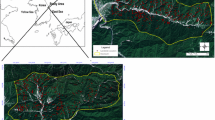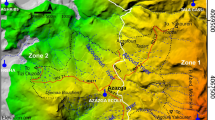Abstract
Catastrophic landslides and associated destructions are increasing every year, because of the change in climatic conditions and land-use patterns. The ecologically sensitive zones of Western Ghats are highly susceptible to landslides and require scientific attention in developing an efficient early warning system. Definition of empirical rainfall thresholds on local, regional or global scales is the most commonly followed method of forecasting rainfall induced landslides. The limitations associated with such thresholds demands for better forecasting performance, incorporating the effect of physical processes in the initiation of landslides. This study is an attempt to forecast landslides in Idukki district, using mobility functions. The function separates the impossible and certain mobilisation parts and forecasts whether landslides can occur or not. Based on the critical value of mobility function, two different warning levels are proposed for four different reference areas in the district. The study shows that the model is 97% efficient in smaller areas with uniform topographical and geological conditions, and the performance is reduced as the area becomes larger, with varying topographical and geological properties. The model proves to be an effective landslide forecasting tool that can be integrated with a rainfall forecasting system, to develop an early warning system for the region.






Similar content being viewed by others
References
DiBiagio E, Kjekstad O (2007) Early warning, instrumentation and monitoring landslides. In: Asian Program for Regional Capacity Enhancement for Landslide Impact Mitigation, RECLAIM II, 29th January–3rd February 2007. Asian Disaster Preparedness Center (ADPC) and Norwegian Geotechnical Institute (NGI), Phuket, Thailand
Kuriakose SL (2010) Physically-based dynamic modelling of the effect of land use changes on shallow landslide initiation in the Western Ghats of Kerala, India
Dikshit A, Satyam DN, Towhata I (2018) Early warning system using tilt sensors in Chibo, Kalimpong, Darjeeling Himalayas, India. Nat Hazards 94:727–741. https://doi.org/10.1007/s11069-018-3417-6
Dikshit A, Satyam DN (2018) Estimation of rainfall thresholds for landslide occurrences in Kalimpong, India. Innov Infrastruct Solut. https://doi.org/10.1007/s41062-018-0132-9
Piciullo L, Calvello M, Cepeda JM (2018) Territorial early warning systems for rainfall-induced landslides. Earth-Sci Rev 179:228–247. https://doi.org/10.1016/j.earscirev.2018.02.013
Abraham MT, Satyam N, Pradhan B, Alamri AM (2020) Forecasting of landslides using rainfall severity and soil wetness: a probabilistic approach for Darjeeling Himalayas. Water 12:0804. https://doi.org/10.3390/w12030804
Mirus BB, Becker RE, Baum RL, Smith JB (2018) Integrating real-time subsurface hydrologic monitoring with empirical rainfall thresholds to improve landslide early warning. Landslides 15:1909–1919. https://doi.org/10.1007/s10346-018-0995-z
Baum RL, Savage WZ, Godt JW (2008) TRIGRS—a fortran program for transient rainfall infiltration and grid-based regional slope stability analysis
Alvioli M, Baum RL (2016) Parallelization of the TRIGRS model for rainfall-induced landslides using the message passing interface. Environ Model Softw 81:122–135. https://doi.org/10.1016/j.envsoft.2016.04.002
Iverson RM (2000) Landslide triggering by rain infiltration. Water Resour Res 36:1897–1910. https://doi.org/10.1029/2000WR900090
Segoni S, Piciullo L, Gariano SL (2018) A review of the recent literature on rainfall thresholds for landslide occurrence. Landslides 15:1483–1501. https://doi.org/10.1007/s10346-018-0966-4
Guzzetti F, Peruccacci S, Rossi M, Stark CP (2007) Rainfall thresholds for the initiation of landslides in central and southern Europe. Meteorol Atmos Phys 98:239–267. https://doi.org/10.1007/s00703-007-0262-7
Melillo M, Brunetti MT, Peruccacci S, et al (2018) TXT-tool 2.039-1.5: an algorithm for the objective reconstruction of rainfall events responsible for landslides. In: Landslide Dynamics: ISDR-ICL Landslide Interactive Teaching Tools. Springer International Publishing, Cham, pp 433–447
Caine N (1980) The rainfall intensity-duration control of shallow landslides and debris flows: an update. Geogr Ann Ser A Phys Geogr 62(1–2):23–27
Aleotti P (2004) A warning system for rainfall-induced shallow failures. Eng Geol 73:247–265. https://doi.org/10.1016/j.enggeo.2004.01.007
Gariano SL, Melillo M, Peruccacci S, Brunetti MT (2020) How much does the rainfall temporal resolution affect rainfall thresholds for landslide triggering? Nat Hazards 100:655–670. https://doi.org/10.1007/s11069-019-03830-x
Capparelli G, Versace P (2011) FLaIR and SUSHI: two mathematical models for early warning of landslides induced by rainfall. Landslides 8:67–79. https://doi.org/10.1007/s10346-010-0228-6
Zhao B, Dai Q, Han D et al (2019) Probabilistic thresholds for landslides warning by integrating soil moisture conditions with rainfall thresholds. J Hydrol 574:276–287. https://doi.org/10.1016/j.jhydrol.2019.04.062
Segoni S, Rosi A, Lagomarsino D et al (2018) Brief communication: using averaged soil moisture estimates to improve the performances of a regional-scale landslide early warning system. Nat Hazards Earth Syst Sci 18:807–812. https://doi.org/10.5194/nhess-18-807-2018
Abraham MT, Satyam N, Bulzinetti MA et al (2020) Using field-based monitoring to enhance the performance of rainfall thresholds for landslide warning. Water 12:3453. https://doi.org/10.3390/w12123453
Versace P, Capparelli G, De Luca DL (2018) TXT-tool 2.039-4.1: FLaIR Model (Forecasting of Landslides Induced by Rainfalls). In: Landslide Dynamics: ISDR-ICL Landslide Interactive Teaching Tools. Springer International Publishing, Cham, pp 381–389
Capparelli G, Tiranti D (2010) Application of the MoniFLaIR early warning system for rainfall-induced landslides in Piedmont region (Italy). Landslides 7:401–410. https://doi.org/10.1007/s10346-009-0189-9
Froude MJ, Petley DN (2018) Global fatal landslide occurrence from 2004 to 2016. Nat Hazards Earth Syst Sci 18:2161–2181. https://doi.org/10.5194/nhess-18-2161-2018
Dikshit A (2019) Analysis of rainfall-induced shallow landslides in Kalimpong, Darjeeling Himalayas, India
Abraham MT, Satyam N, Pradhan B, Alamri AM (2020) IoT-based geotechnical monitoring of unstable slopes for landslide early warning in the Darjeeling Himalayas. Sensors 20:2611. https://doi.org/10.3390/s20092611
Abraham MT, Satyam N, Kushal S et al (2020) Rainfall threshold estimation and landslide forecasting for Kalimpong, India Using SIGMA Model. Water 12:1195. https://doi.org/10.3390/w12041195
Abraham MT, Satyam N, Reddy SKP, Pradhan B (2020) Runout modeling and calibration of friction parameters of Kurichermala debris flow. India. Landslides. https://doi.org/10.1007/s10346-020-01540-1
Kuriakose SL, Sankar G, Muraleedharan C (2009) History of landslide susceptibility and a chorology of landslide-prone areas in the Western Ghats of Kerala, India. Environ Geol 57:1553–1568. https://doi.org/10.1007/s00254-008-1431-9
Jose JP (2020) Death by landslides in God’s own country. Line, Hindu
Department of Mining and Geology Kerala (2016) District Survey Report of Minor Minerals. Thiruvananthapuram
Iiritano G, Versace P, Sirangelo B (1998) Real-time estimation of hazard for landslides triggered by rainfall. Environ Geol 35:175–183. https://doi.org/10.1007/s002540050303
Berti M, Martina MLV, Franceschini S et al (2012) Probabilistic rainfall thresholds for landslide occurrence using a Bayesian approach. J Geophys Res Earth Surf 117:1–20. https://doi.org/10.1029/2012JF002367
Abraham MT, Pothuraju D, Satyam N (2019) Rainfall thresholds for prediction of landslides in Idukki, India: an empirical approach. Water 11:2113. https://doi.org/10.3390/w11102113
India Meteorlogical Department (2019) India Meteorological Department (IMD) Data Supply Portal
Abraham MT, Satyam N, Rosi A (2020) Empirical rainfall thresholds for occurrence of landslides in Wayanad, India. EGU Gen Assem. https://doi.org/10.5194/egusphere-egu2020-167
Abraham MT, Satyam N, Rosi A et al (2020) The selection of rain gauges and rainfall parameters in estimating intensity-duration thresholds for landslide occurrence: case study from Wayanad (India). Water 12:1000. https://doi.org/10.3390/w12041000
Baum R, Godt J, Harp E, et al (2005) Early warning of landslides for rail traffic between Seattle and Everett, Washington, U.S.A. In: International of Conference on Landslide Risk Management. Vancouver, pp 731–740
Rabuffetti D, Barbero S (2005) Operational hydro-meteorological warning and real-time flood forecasting: the Piemonte Region case study. Hydrol Earth Syst Sci 9:457–466. https://doi.org/10.5194/hess-9-457-2005
Martelloni G, Segoni S, Fanti R, Catani F (2012) Rainfall thresholds for the forecasting of landslide occurrence at regional scale. Landslides 9:485–495. https://doi.org/10.1007/s10346-011-0308-2
Segoni S, Rosi A, Fanti R et al (2018) A regional-scale landslide warning system based on 20 years of operational experience. Water 10:1297. https://doi.org/10.3390/w10101297
Lagomarsino D, Segoni S, Rosi A et al (2015) Quantitative comparison between two different methodologies to define rainfall thresholds for landslide forecasting. Nat Hazards Earth Syst Sci 15:2413–2423. https://doi.org/10.5194/nhess-15-2413-2015
Geological Survey of India (2010) Geology and minerals: district Resource Map. Idukki. Geological Survey of India, Southern Region, Hyderabad, Government of India
Acknowledgements
The authors are grateful to Geological Survey of India Kerala State Unit, Kerala State Disaster Management Authority (KSDMA) and District Soil Conservation Office, Idukki, for the support they have offered for the research. The authors are also grateful to all the reviewers for their constructive suggestions.
Author information
Authors and Affiliations
Corresponding author
Additional information
Publisher's Note
Springer Nature remains neutral with regard to jurisdictional claims in published maps and institutional affiliations.
Rights and permissions
About this article
Cite this article
Abraham, M.T., Satyam, N. & Pradhan, B. Forecasting Landslides Using Mobility Functions: A Case Study from Idukki District, India. Indian Geotech J 51, 684–693 (2021). https://doi.org/10.1007/s40098-020-00490-8
Received:
Accepted:
Published:
Issue Date:
DOI: https://doi.org/10.1007/s40098-020-00490-8




